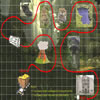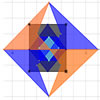All Activities
Vectors and Transformations
On the other pages in this section we have divided our activities in to sub-topics. This page has them all together in one place for browsing
congruent halves | |
| |
 |
|
 |
|
 |
|
| |
 |
Time: 1-2hrs Students often think reflection is easy, but the big change at this level is the need to define, using equations, the position of the mirror line. This activity uses Geogebra and/or Autograph to explore points on different lines to remind students why lines can be defined using equations. Three further |
 |
|
| transformations and tessellations | |
 |
|
 |
|
 |
|
